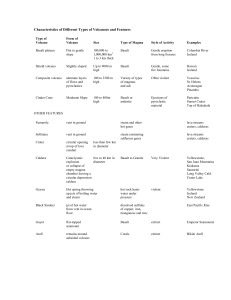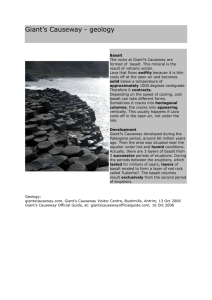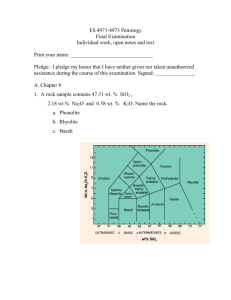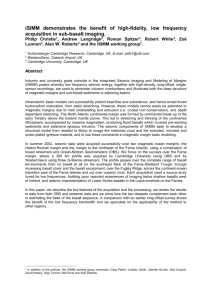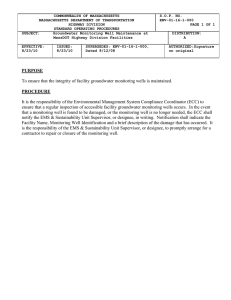Research Journal of Environmental and Earth Sciences 4(4): 440-447, 2012
advertisement
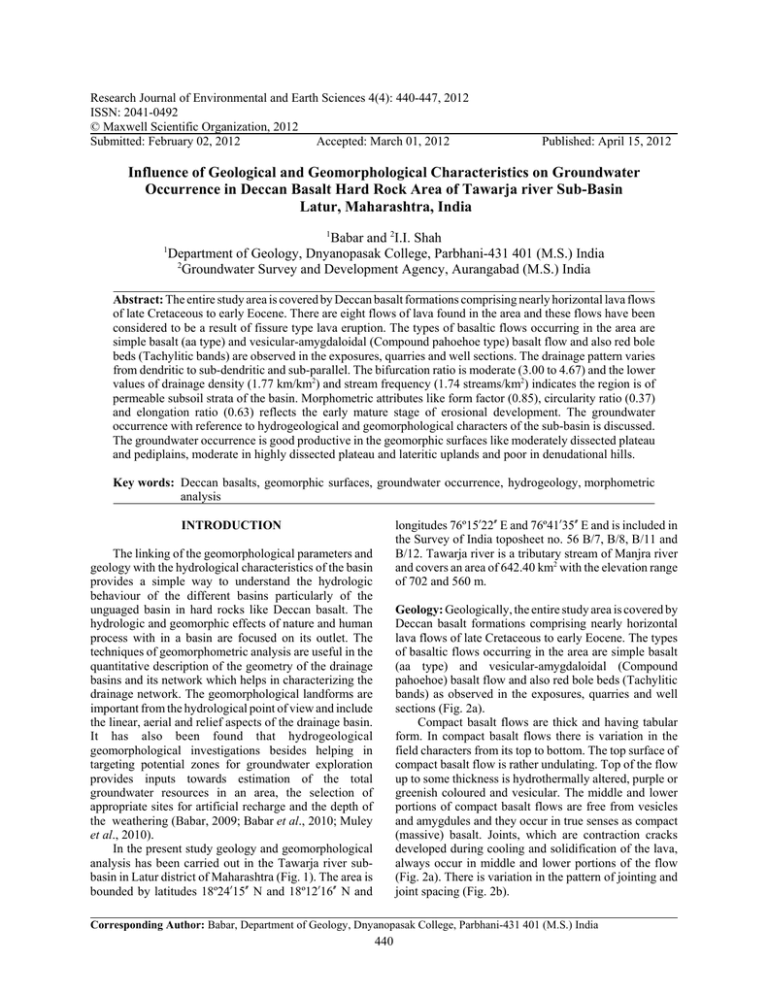
Research Journal of Environmental and Earth Sciences 4(4): 440-447, 2012 ISSN: 2041-0492 © Maxwell Scientific Organization, 2012 Submitted: February 02, 2012 Accepted: March 01, 2012 Published: April 15, 2012 Influence of Geological and Geomorphological Characteristics on Groundwater Occurrence in Deccan Basalt Hard Rock Area of Tawarja river Sub-Basin Latur, Maharashtra, India 1 1 Babar and 2I.I. Shah Department of Geology, Dnyanopasak College, Parbhani-431 401 (M.S.) India 2 Groundwater Survey and Development Agency, Aurangabad (M.S.) India Abstract: The entire study area is covered by Deccan basalt formations comprising nearly horizontal lava flows of late Cretaceous to early Eocene. There are eight flows of lava found in the area and these flows have been considered to be a result of fissure type lava eruption. The types of basaltic flows occurring in the area are simple basalt (aa type) and vesicular-amygdaloidal (Compound pahoehoe type) basalt flow and also red bole beds (Tachylitic bands) are observed in the exposures, quarries and well sections. The drainage pattern varies from dendritic to sub-dendritic and sub-parallel. The bifurcation ratio is moderate (3.00 to 4.67) and the lower values of drainage density (1.77 km/km2) and stream frequency (1.74 streams/km2) indicates the region is of permeable subsoil strata of the basin. Morphometric attributes like form factor (0.85), circularity ratio (0.37) and elongation ratio (0.63) reflects the early mature stage of erosional development. The groundwater occurrence with reference to hydrogeological and geomorphological characters of the sub-basin is discussed. The groundwater occurrence is good productive in the geomorphic surfaces like moderately dissected plateau and pediplains, moderate in highly dissected plateau and lateritic uplands and poor in denudational hills. Key words: Deccan basalts, geomorphic surfaces, groundwater occurrence, hydrogeology, morphometric analysis longitudes 76º15!22" E and 76º41!35" E and is included in the Survey of India toposheet no. 56 B/7, B/8, B/11 and B/12. Tawarja river is a tributary stream of Manjra river and covers an area of 642.40 km2 with the elevation range of 702 and 560 m. INTRODUCTION The linking of the geomorphological parameters and geology with the hydrological characteristics of the basin provides a simple way to understand the hydrologic behaviour of the different basins particularly of the unguaged basin in hard rocks like Deccan basalt. The hydrologic and geomorphic effects of nature and human process with in a basin are focused on its outlet. The techniques of geomorphometric analysis are useful in the quantitative description of the geometry of the drainage basins and its network which helps in characterizing the drainage network. The geomorphological landforms are important from the hydrological point of view and include the linear, aerial and relief aspects of the drainage basin. It has also been found that hydrogeological geomorphological investigations besides helping in targeting potential zones for groundwater exploration provides inputs towards estimation of the total groundwater resources in an area, the selection of appropriate sites for artificial recharge and the depth of the weathering (Babar, 2009; Babar et al., 2010; Muley et al., 2010). In the present study geology and geomorphological analysis has been carried out in the Tawarja river subbasin in Latur district of Maharashtra (Fig. 1). The area is bounded by latitudes 18º24!15" N and 18º12!16" N and Geology: Geologically, the entire study area is covered by Deccan basalt formations comprising nearly horizontal lava flows of late Cretaceous to early Eocene. The types of basaltic flows occurring in the area are simple basalt (aa type) and vesicular-amygdaloidal (Compound pahoehoe) basalt flow and also red bole beds (Tachylitic bands) as observed in the exposures, quarries and well sections (Fig. 2a). Compact basalt flows are thick and having tabular form. In compact basalt flows there is variation in the field characters from its top to bottom. The top surface of compact basalt flow is rather undulating. Top of the flow up to some thickness is hydrothermally altered, purple or greenish coloured and vesicular. The middle and lower portions of compact basalt flows are free from vesicles and amygdules and they occur in true senses as compact (massive) basalt. Joints, which are contraction cracks developed during cooling and solidification of the lava, always occur in middle and lower portions of the flow (Fig. 2a). There is variation in the pattern of jointing and joint spacing (Fig. 2b). Corresponding Author: Babar, Department of Geology, Dnyanopasak College, Parbhani-431 401 (M.S.) India 440 Res. J. Environ. Earth. Sci., 4(4): 440-447, 2012 Fig. 1: Drainage and topographical map of Tawarja river sub-basin Fig. 2: (a) Compact basalt showing closely spaced jointing and red bole bed (b) Variation in the pattern of jointing and joint spacing in compact babalt Table 1: Deccan basalt lava flows observed in the long section along the Tawarja river S.No. Flow No. Lithology of the flow 1 VIII Jointed compact basalt flow (fine grained massive and moderately weathered) 2 VII Highly weathered vesicular amygdaloidal basalt flow 3 VI Jointed compact basalt flow (fine grained massive, grey to dark grey coloured and poorly weathered) 4 Red bole bed 5 V Compact basalt flow (fine grained massive and moderately weathered) 6 Red bole bed 7 IV Highly weathered vesicular amygdaloidal basalt flow 8 III Jointed compact basalt flow (fine grained massive, dark grey coloured and highly to moderately weathered) 9 II Poorly weathered/un-weathered vesicular amygdaloidal basalt flow 10 I Jointed compact basalt flow (fine grained massive, dark brownish coloured and poorly weathered) The vesicular amygdaloidal basalt (compound Pahoehoe) flows are formed by the outpouring of comparatively viscous lava in small quantities through a large number of outlets (Gupte, 1971; Kulkarni et al., 1980). Therefore, amygdaloidal basalt flows have small sizes having irregular forms and limited lateral extent. Altitude range (m) 702.00 to 685.00 685.00 to 675.00 675.00 to 643.00 643.00 to 642.00 642.00 to 634.00 634.00 to 633.00 633.00 to 621.00 621.00 to 580.00 580.00 to 569.00 569.00 to 560.00 There are eight basalt flows in the Tawarja river subbasin area occurring between the elevations of 702 to 560 m above msl. The flows vary in average thickness about 18 m. The characters of basalt flows are given in Table 1 and all the flows are given in Fig. 3. Out of eight flows of basalt five flows are of compact/massive (aa type) basalt 441 Res. J. Environ. Earth. Sci., 4(4): 440-447, 2012 Fig. 3: Eight flows of basalt occurring along X-X’ section (location given in Fig. 1) of Tawarja River (I to VIII are numbers of lava flows) Fig. 4: (a) Compact basalt and amygdaloidal basalt flows separated by red bole bed, (b) Compact basalt showing jointing with the spheroidal weathering flows (Flow No VIII, VI, V, III and I), two flows of weathered amygdaloidal (pahoehoe type) basalt flows (Flow No. VII and IV) and one flow is poorly weathered/un-weathered vesicular-amygdaloidal (Flow No. II, Fig. 4a). Compact/massive basalt Flow No. VIII, III and I show the closely spaced joints, Flow No. VI shows jointing with the spheroidal weathering (Fig. 4b) whereas Flow No. V is compact basalt with non-inter connected and inconsistent joints. The vesicular and amygdaloidal basalts also show weathering and development of sheet jointing. The red bole bed (Fig. 2a) occurs at the top of Flow No IV and having thickness varying from few centimetres to about 1m. In vesicular-amygdaloidal basalts the vesicles are filled with green chlorophaeite, zeolites and calcite. The morphometric analysis include the assessment of various parameters like bifurcation ratio, length and area ratios, basin configurations, drainage density, stream frequency, length of overland flow and relief aspects (Channel gradient, relief ratio, ruggedness number and hypsometric integrals) of the Tawarja sub-basin. In morphometric analysis of the sub-basin the stream order is determined following the method of Strahler (1957). Accordingly the Tawarja river is of Sixth order. The bifurcation ratio (Rb) is the ratio of number of stream segments of a given order (Nu) and the number of stream segments of next higher order (Nu + 1). Bifurcation ratios in general have a range from about 2.0 for flat or rolling areas to 3.0 to 5.0 for mountainous, hilly and highly dissected basins (Horton, 1945). Bifurcation ratio registers very small variation from region to region irrespective of structural control (Singh et al., 1984). Strahler (1964) found that bifurcation ratio characteristically ranges between 3.0 and 5.0 in watersheds in which the geological structures do not distort the drainage basin. Bifurcation ratios of Tawarja river sub-basin ranges from 3.0 to 4.67 (Table 2). Geomorphology: The drainage network of streams of Tawarja sub-basin (Fig. 1) shows dendritic to subdendritic and sub-parallel drainage pattern. The development of dendritic to sub-dendritic drainage in the sub-basin indicates the area of massive jointed rock types, gently sloping to almost horizontal terrain and low relief. 442 Res. J. Environ. Earth. Sci., 4(4): 440-447, 2012 Table 2: Bifurcation ratio, length ratio and area ratio of Tawarja sub-basin Stream No. of Bifurcation Stream length Mean stream order streams ratio (Km) length 1 872 633.30 0.73 4.67 2 187 239.65 1.28 4.45 3 42 138.93 3.31 3.50 4 12 80.99 6.75 4.00 5 3 7.59 2.53 3.00 6 1 34.37 34.37 Total 1117 1134.83 - Length ratio Stream area (Km-2) 373.20 Mean stream area 0.43 465.80 2.51 432.75 10.30 482.43 40.20 368.70 122.90 642.40 642.40 642.40 - Area ratio 1.75 5.84 2.59 4.10 2.04 3.90 0.37 3.06 13.58 5.23 - - 100 C 100 Mean stream area B Mean stream length Number of stream A 10 40 1 1 1 1 2 3 4 Stream order 5 6 1 3 Stream order 5 2 3 4 Stream order 5 6 0.4 Fig. 5: (a) Semilog plot of stream order vs number of streams, (b) Semilog plot of stream order vs mean streams length and (c) Semilog plot of stream order vs mean streams area Table 3: Morphometric parameters of Tawarja river sub-basin S.No. Parameters Values 1 Total basin area (A) Sq. Km. 642.40 2 Maximum basin length (l) Km 45.25 3 Total stream length (L) Km 1134.83 4 Basin perimeter (P) Km 148.40 5 Radius of the circle with the perimeter as 23.63 circumference (r) Km 6 Area of the circle with same perimeter 1753.30 (Ao) Km2 7 Form factor (F = A/l2) 0.85 8 Circularity ratio (C = A/Ao) 0.37 2 9 Compactness ratio (K = 4BA/P ) 0.37 10 Diameter of the circle of the area of the 28.60 basin (lo) Km. 11 Elongation ratio (lo/L) 0.63 12 Drainage density (Dd = L/A) Km/Km2 1.77 13 Total number of streams (N) 1117 14 Streams frequency (Fs = N/A) streams/Km2 1.74 15 Length of overland flow (1/2Dd) Km. 0.28 16 Infiltration number (If) 3.08 17 Maximum basin relief (H)m 136 18 Relief ratio 0.003 19 Ruggedness number (H/L) 0.24 20 Slope of the ground surface (Hx2Dd) m/km 0.48 The number of streams of each order is plotted against the corresponding stream order of the Tawarja sub-basin (Fig. 5a). The plot shows that the number of streams of given orders in the sub-basin forms an inverse geometric sequence by decreasing systematically with increasing order in conformity to the Horton (1945) ‘law of stream numbers’. The lengths of the various stream segments were measured order wise and the total lengths as well as the mean stream length for each order were computed. The length ratio, which is the ratio of the mean length of the streams of a given order to the mean length of the streams of the next lower order, was then calculated for each pair of order (Table 2). The plot of mean stream length of each order against stream order (Fig. 5b) gives exponential form around the regression line. It is apparent from the plots that the average length of streams of a given order forms a direct geometric sequence by increasing systematically with order and thus conforms to Horton (1945) ‘law of stream length’. The areas of each order were computed and calculated the mean stream areas of each order. Then taking pairs of stream orders, the area ratios were obtained between the mean areas of the basins of one order and that of the next lower order (Table 2). The mean basin area of the streams of a given order is plotted against corresponding order in exponential form (Fig. 5c). The relationship shows that the mean basin area of corresponding order increases systematically with increasing order, which is in conformity to the Schumm (1956) ‘law of basin area’. The values of circularity ratio (0.37) and elongation ratio (0.63) (Table 3) indicates that the sub-basin is 443 Res. J. Environ. Earth. Sci., 4(4): 440-447, 2012 Table 4: Well inventory and yield particulars of wells in Tawarja river sub-basin Observation wells Range of depth to water (m bg1) ------------------------------------------------------------Geomorphic Range of Sr No. unit Types Nos, depth (m) Pre-monsoon Post-monsoon 1 Highly dissected DW 3 8.5-12.2 6.5-12.4 3.1-5.4 plateau BW 5 50.0-70.0 10.5-26.9 5.2-10.2 2 Moderately DW 4 9.5-14.0 2.5-5.5 1.0-3.0 dissected plateau BW 7 32.0-60.0 4.8-9.5 2.0-4.5 3 Pediplains DW 6 10.0-15.0 5.5-10.5 2.5-4.5 DBW 5 15.0-20.0 6.8-10.6 3.8-5.2 BW 6 40.0-65.0 8.5-15.6 4.5-5.8 4 Lateritic upland DW 3 9.5-14.0 2.5-5.5 1.0-3.0 BW 7 32.0-60.0 4.8-9.5 2.0-4.5 5 Denudational hills BW 03 45.0-62.5 12.0-30.0 6.4-11.5 DW: Dug well DBW; Dug: Cum bore well; BW: Bore well; lpm: Litre per minute Water table fluctuation (m) 3.4-7.0 5.3-16.7 1.5-2.5 2.8-5.0 3.0-6.0 3.0-5.4 4.0-9.8 1.5-2.5 3.8-5.0 5.6-18.5 Range of yield (1pm) 75-95 95-150 100-180 150-185 150-195 165-206 210-315 100-180 95-160 60-85 Av. yield (l pm) 83 125 160 170 178 185 270 160 135 72 Fig. 6: Geomorphological map of Tawarja river sub-basin The value of infiltration ratio for the sub-basin indicates that there is possibility of higher infiltration and lower run-off. It also suggests that the possibility of jointing/fracturing and deep weathering of the basaltic rocks present in the sub-basin. Field traverses corroborate this influence that lithology and geology of the area plays an important role in the development of drainage density and stream frequency. The relief measures of the watershed are higher i.e., maximum basin relief is 136 m, channel gradient 3.01 m/km, relief ratio 0.003 and ruggedness number 0.24, which also reflect the fact that the sub-basin lie within hilly terrain. These relief measures also show that the subbasin has early maturity stage of erosional development. Geomorphology of an area is one of the most significant features in evaluation of the groundwater potential. Considering the importance, different geomorphic surfaces are mapped using the satellite imagery. The geomorphic surfaces (Fig. 6) obtained are: Highly Dissected Plateau, Moderately Dissected Plateau, moderately compact and elongated similar to that obtained by Jain (2006) in Sonar river basin. The shape of a drainage basin is significant since it affects the stream discharge characteristics (Strahler, 1968) and the subbasin is in the late mature stage of erosional development. The values of drainage density and stream frequency are lower indicating the characteristic of regions of incompetent and impermeable subsurface materials, sparse vegetation and mountainous relief (Strahler, 1964). In the study area the drainage density (Dd) and stream frequency (Fs) are somewhat lower i.e., Dd = 1.77 km/km2 and Fs = 1.74 streams/km2, Table 4) which correspond to the highly or moderately dissected plateau surfaces, denudational hills and lateritic uplands of the sub-basin with sparse vegetation and impermeable subsurface rocks in pediplains. The length of overland flow is low for the sub-basin (0.28 km) indicating the less amount of water is to be run before concentrated in the stream channel. Melton (1957) related it with runoff process and concentration of time. 444 Res. J. Environ. Earth. Sci., 4(4): 440-447, 2012 Major problems of these surfaces are gully erosion, development of deep and wide cracks, water logging and soil salinity. The irrigation in pediplain is mainly done through dug wells and dug-cum bore wells. Water table fluctuation ranges from 1.5 to 2.5 m bgl in dug wells 3.0 to 5.4 in dug cum bore wells and 4.0 to 5.8 m in bore wells. The average yield of dug wells is 178 lpm, dug cum bore well is 185 lpm and bore wells is 270 lpm. Hence the yield of groundwater in this area is good. Pediplains, Denudational Hills and Lateritic upland. The groundwater potential of each geomorphic surface is discussed. Highly dissected plateau: The highly dissected plateaus are fractured and weathered surfaces and occurring in marginal part of the sub-basin. The land of this unit is severely dissected by the streams of Tawarja river giving rise to a terrain consisting of flat-topped ridges and steep scarps. The dissected plateau is characterised by the shallow soil cover, moderately high relief, moderately steep slope, rocky and rugged terrain and hard and compact basalt bed rock, which makes them unsuitable for agriculture (Pofali et al., 1985, 1995). The area has favourable sties for development of reservoirs, which can be utilized to store runoff water for groundwater recharge as well as for irrigation of plains in its vicinity. The stony wastes and waste lands are by and large used for quarrying stones as building material and as grazing lands respectively (Singh, 1995). In highly dissected plateau unit the groundwater potentiality is moderate. The water table fluctuations are ranging from 3.4 to 7.0 m bgl in dug wells and 5.3 to 16.2 m bgl in bore wells. The average yield in highly dissected plateau is 83 lpm in dug wells and 125 lpm in bore wells i.e., the yield is moderate. Lateritic uplands: These are the upland surfaces developed over highly dissected plateau areas occurring as capped rocks. They show reddish colour due to presence of the lateritic cap rock on the basalts. The vesicular type of basalts is highly altered which gave rise to laterites. In the study area there are 8 flows of traps of which the compact basalt flows are not weathered and are jointed, whereas the VII and IV flow are weathered vesicular amygdaloidal basalt and at some places altered to laterites. Thus laterites occur as cap rocks over vesicular-amygdaloidal basalt and form flat plateaus and tablelands at elevation range from 600 to 660 asl. They have cavities often filled with yellowish to reddish clayey material. Water table fluctuation ranges from 2.5 to 3.5 m bgl in dug wells 3.8 to 5 in dug cum bore wells and 3.8 to 5 m in bore wells. The average yield of dug wells is moderate i.e., 140 lpm and bore wells is 135 lpm Moderately dissected plateau: These are moderately fractured and weathered surfaces and occurring in central part of the sub-basin. The land of this unit is dissected by the streams of Tawarja river giving rise to a terrain consisting of gently sloping plateau surface. It is characterised by the moderately thick soil cover, moderate relief, gently sloping terrain and basaltic bed rock. It lies parallel to the stream course. It has low drainage density (1.5 to 2 km/km2) and elevation range of 660 to 620 m above msl. The weathered zone thickness ranges from 5 to 15 m. Dug wells are commonly seen in this zone. The irrigation in this zone is mainly done through dug wells and bore wells. Groundwater potential in moderately dissected plateau is good along fractures where groundwater can be obtained for domestic purpose. The water table fluctuations are ranging from 3.0 to 6.0 m bgl in dug wells and 2.8 to 5.4 m bgl in bore wells. The average yield of dug well is 160 lpm and of bore well is 170 lpm i.e., the yield is good. Denudational hills: A group of massive hills with resistant rock bodies that are formed due to different erosional and weathering processes and occupying in northern and north-eastern part of the Tawarja river are denudational hills. The average elevation of these hill ranges is about 660 to 680 m above msl. These geomorphic surfaces have the very shallow soil cover and are of less potential for agriculture and groundwater. The yield of groundwater in this area is poor (i.e., 72 lpm in bore wells). Groundwater occurrences in deccan basalt hard rock: Water table depth in Deccan trap region generally varies with topography and the nature of aquifer (Agrwal, 1987; Patil, 1990; Bhatt and Salpekar, 1990; Agrwal, 1995; Adyalkar et al., 1996; Khadri et al., 1988).The rainfall also plays an important role in the water level fluctuation. The inherent low porosity and low hydraulic conductivity of basalts implies that the Deccan basalts possess low to moderate storativity and transmissivity (Kulkarni et al., 2000). Their potential, mainly the transmissivity is enhanced, if the basalts are transacted by fracture zones. Typical un-jointed compact basalts do not have the ability to store groundwater, whereas the vesicular-amygdaloidal basalts due to presence of vesicles (open gas cavities) and amygdales (gas cavities filled by secondary minerals) tend to be more deeply weathered and jointed. However, the Pediplains: These surfaces are formed by the weathering of the dissected plateaus. They are characterized by high porosity, permeability and infiltration rate and hence have the good yield of the groundwater (Table 3). They are found in the central portion adjacent to moderately dissected plateau. These geomorphic surfaces have good potential for agriculture, especially for crops/plantations like sugarcane, banana, grapes, chillies, sunflower and vegetables in addition to cotton, sorghum and wheat. 445 Res. J. Environ. Earth. Sci., 4(4): 440-447, 2012 presence of vesicles and amygdales is not only the deciding factor, but also a combination of weathering; jointing and fracture patterns over a particular lithology often enhance the potential of basalt aquifers on a local scale. The study area is constituted by an alternate sequence of compact (massive) and vesicular-amygdaloidal type basaltic flows. Though all the subunits from each flow were differentiated in the field, they could not be separated out on the map due to their highly spatial variability. However, well sections and stone quarries expose the geometry of these subunits and this was taken into consideration and recorded in the well-inventory data. Each flow can actually be subdivided in an upper vesicular-amygdaloidal subunit (highly heterogeneous in nature) and a lower, sub-vertically jointed compact basalt subunit. This division is in accordance with the lithological model (Kale and Kulkarni, 1992) and the conceptual hydrogeological model (Kulkarni et al., 2000) that is commonly used in many parts of the Deccan volcanic province. In a typical basalt flow in the area the vesicular-amygdaloidal subunits are overlain by red tuffs with sheet jointing, grading downwards into somewhat massive amygdaloidal basalts. At places, entire vesicularamygdaloidal subunit is extensively sheet jointed. On account of its heterogeneity and presence of sheet joints, vesicular-amygdaloidal basalt is likely to possess a higher specific yield and hydraulic conductivity than its underlying compact basalt counterpart. The compact basalt subunit underlying the vesicularamygdaloidal basalt is sub vertically jointed. Compact basalts are denser and more homogeneous than vesicularamygdaloidal basalts. The upper portions show a larger frequency of jointing than the lower parts. Most of the times, the lower parts of compact basalts may be devoid of any joints. It can be visualized that a large component of groundwater accumulation and flow occurs within the weathered and jointed-fractured portions of alternating sequences of basaltic units. The openings facilitating groundwater storage and movement are the sheet joints of the vesicular-amygdaloidal basalt and the vertical and sub vertical joints of compact basalt subunits. Groundwater systems in Deccan basalt are a result of the alternate arrangement of sheet jointed vesicularamygdaloidal basalts and the sub-vertically jointed to unjointed compact basalts (Kulkarni and Deolankar, 1995; Kulkarni et al., 2000). The groundwater systems of the study area are constituted by such a lithological setup. zone of secondary porosity developed in the rocks due to fractures, joints and amount of weathering. Geomorphologically, the Terna river sub-basin area is divided into areas occupied by highly dissected plateau, moderately dissected plateau, pediplains, lateritic upland and denudational hills. By studying the hydrogeological and geomorphological conditions of the sub-basin, it is possible to decipher the groundwater potentiality. It is productive in the geomorphic surfaces like moderately dissected plateau and pediplains, moderate in highly dissected plateau and lateritic uplands and poor in denudational hills. Dug wells are recommended in the weathered areas of moderately dissected plateau. Some of the dug wells in the pediments and in moderately dissected plateau dry up during pre monsoon period hence bore wells and dug-cum bore wells are recommended for these areas. ACKNOWLEDGMENT The authors gratefully acknowledge the financial support by Swami Ramanand Teerth Marathwada University, Nanded (Maharashtra) under the Research project No. BCUD/Min.Univ./Science/2009-10/3857 dated 27.03.2010. REFERENCES Adyalkar, P.G., R.S. Ayyangar, S.S. Tikekar and Y.D. Khare, 1996. Groundwater potential of Deccan Flood Basalt of Nagpur District in Maharashtra: An imprint derived from satellite imagery in Deccan basalt. Gondwana Geol. Soc., 2: 485-492. Agrwal, P.K., 1987. Groundwater resources and development potential of Parbhani district. Maharashtra CGWB Rep. No. 353/DR/9/87, pp: 1-19. Agrwal, P.K., 1995. The Techno-economic aspect of groundwater potential and development in Deccan flood basalts, Maharashtra. Gondwana Geol. Mag., 10: 79-88. Babar, M.D., 2009. Integrated Studies on Water Resource Management and Conservation in Karpara River Sub-basin in Parbhani District by Using Remote sensing and GIS. Proceeding Volume of National Conference held at Ambajogai. Babar, M.D., R.V. Chunchekar and B.B. Ghute, 2010. Hydrogeomorphological Mapping by Remote Sensing Application in Terna River Sub-basin, Latur-Osmanabad Districts, Maharashtra, India. In Proceeding Volume of 3rd International Conference on Hydrology and watershed Management held at Hyderabad held during February 3-6, 2: 1022-1030. CONCLUSION Tawarja river is a sixth order stream with dendritic to sub dendritic and sub parallel drainage pattern. Geologically, the area is occupied by Deccan Basalts of late Cretaceous to early Eocene period. As the primary porosity is limited to gas cavities (vesicles), the groundwater in the area is therefore concentrated in the 446 Res. J. Environ. Earth. Sci., 4(4): 440-447, 2012 Bhatt, M.K. and P.R. Salpekar, 1990. Artificial recharge through bore wells in proble village Kaij, District Beed. Proc. Vol. of Seminar on “Modern Techniques of Rainwater Harvesting, Water Conservation and Artificial Recharge for Drinking Water. Afforestation, Horticulture and Agriculture, pp: 271-274. Gupte, R.B., 1971. Engineering aspects of Deccan trap basalt. Maharashtra Public Work J., 7(3-4): 7-20. Horton, R.E., 1945. Erosional development of streams and their drainage basins: Hydrophysical approach to Quantitative morphology. Bull. Geol. Soc. Am., 56: 275-370. Jain, S.K., 2006. Hydrogeology and Environmental Geology of Sonar River Basin. Scientific Publishers, India, pp: 12-53. Kale, V.S. and H. Kulkarni, 1992. IRS-1A and LANDSAT data in mapping Deccan Trap flows around Pune: Implications on hydrogeological modeling. Arch. Int. Soc. Photogramm Rem. Sens., 29: 429-435. Khadri, S.F.R., K.V. Subbarao, P.R. Hooper and J.N. Walsh, 1988. Stratigraphy of Thakurwadi formation, Western Deccan basalt province. Geol. Soc. India Mem., 10: 281-304. Kulkarni, H. and S.B. Deolankar, 1995. Hydrogeological mapping in the Deccan Basalt-An appraisal. J. Geol. Soc. Indian, 46(4): 345-352. Kulkarni, S.R., B.N. Karmarkar and R.B. Gupte, 1980. Variation in the nature of Deccan trap volcanicity of western Maharashtra in time and space. Memoir Geol. Soc. India, 3: 143-152. Kulkarni, H., S.B. Deolankar, A. Lalwani, B. Joseph and S. Pawar, 2000. Hydrogeological framework for the Deccan basalt groundwater systems, westcentral India. Hydrogeol. J., 8(4): 368-378. Melton, M.A., 1957. An analysis of the relation among elements of climate, surface properties and geomorphology. Off. Nav. Res. (U.S.), Geogr. Branch, Project 389-042, Tech. Rep., 11: 102. Muley R.B., M.D. Babar, S.M. Atkore and B.B. Ghute, 2010. Application of Remote sensing and Hydrogeological Characteristics for Groundwater Potential Zone in Purna Tahsil (Block) Parbhani District, Maharashtra. Proceeding Volume of Workshop on Application of Remote Sensing and Gis in Water Resources Management, held at Hydrabad, pp: 28-36. Patil, V.Y., 1990. Performance of bore wells in the Manjra basin in Beed Dist. Proc. Vol. of Seminar on “Modern Techniques of Rainwater Harvesting, Water Conservation and Artificial Recharge for Drinking Water, Afforestation, Horticulture and Agriculture, pp: 146-149. Pofali, R.M., J.I. Sehgal and M. Swaminathan, 1985. Problems and Potentials of Pedogeomorphic surfaces in the Basin of Purna. In: Sharma, H.S., (Ed.), Indian Geomorphology. CBC Publ., New Delhi, pp: 81-93. Pofali, R.M, S.T. Gaikwad and M. Swaminanathan, 1995. Study of Geomorphic Features in Chandrapur District, Maharashtra. In: Jog, S.R., (Ed.), Indian Geomorphology. Rawat Publications, Jaipur, 2: 221-229. Schumm, S.A., 1956. The evolution of drainage systems and slopes in bad lands at Perth, Amboi, New Jersey. Geol. Soc. Ame. Bull., 67(5): 597-646. Singh, S., S.S. Ojha and S.P. Agnihotri, 1984. On the Regional Variations in Bifurcation Ratios. In: Mukhopadhyay, S.C., (Ed.), Geomorphological Mosaic. Calcutta University, India, pp: 203-210. Singh, S., 1995. Geomorphology in the Appraisal of Natural Resources. In: Jog, S.R., (Ed.), Indian Geomorphology, Rawat Publ. Jaipur, pp: 193-210. Strahler, A.N., 1957. Quantitative analysis of watershed geomorphology. Tans. Am. Geophys. Union, 38: 931. Strahler, A.N., 1964. Quantitative Geomorphology of Drainage Basin and Channel Networks. In: Chow, V.T., (Ed.), Handbook of Applied Hydrology. McGraw-Hill, New York., pp: 4.39-4.76. Strahler, A.N., 1968. Quantitative Geomorphology. In: Fairbridge, R.W., (Ed.), the Encyclopedia of Geomorphology. Reinhold Book Crop, New York. 447
